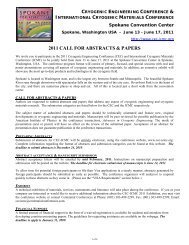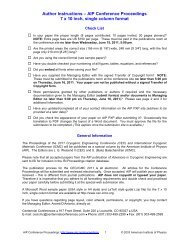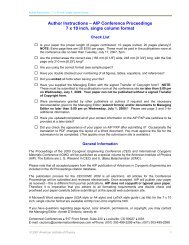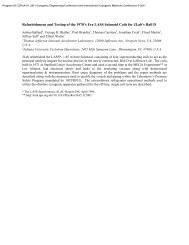CEC Abstracts in PDF format (as of 7/3/07) - CEC-ICMC 2013
CEC Abstracts in PDF format (as of 7/3/07) - CEC-ICMC 2013
CEC Abstracts in PDF format (as of 7/3/07) - CEC-ICMC 2013
Create successful ePaper yourself
Turn your PDF publications into a flip-book with our unique Google optimized e-Paper software.
<strong>CEC</strong> 20<strong>07</strong> - <strong>Abstracts</strong><br />
C2-C-04 An aerospace m<strong>in</strong>iature pulse tube cryocooler at<br />
80K<br />
H.L. Chen, L.W. Yang, J.H. Cai, J.T. Liang, Y. Zhou,<br />
Technical Institute <strong>of</strong> Physics and Chemistry, CAS.<br />
An eng<strong>in</strong>eer<strong>in</strong>g model <strong>of</strong> a m<strong>in</strong>iature pulse tube cryocooler is<br />
designed for space application. Coaxial configuration <strong>of</strong> the cold<br />
f<strong>in</strong>ger is convenient to connect with the aim element and improves<br />
<strong>in</strong>tegration. A series <strong>of</strong> jo<strong>in</strong>t<strong>in</strong>g cooler products are manufactured and<br />
tested. The overall m<strong>as</strong>s <strong>of</strong> the whole cooler system is around 3.5kg.<br />
The product coolers can provide 0.7W cool<strong>in</strong>g capacity at 80K with<strong>in</strong><br />
40W <strong>in</strong>put electric power, while the experimental ones can proveide<br />
more than 0.8W cool<strong>in</strong>g capacity. To make a product for space<br />
application, <strong>in</strong>tense structure, light weight and small size are needed,<br />
so different materials and structures et al. decre<strong>as</strong>e the cool<strong>in</strong>g<br />
performance more or less. Reliability <strong>of</strong> the cooler work<strong>in</strong>g<br />
cont<strong>in</strong>ously is tested. Also, the magnetic field <strong>of</strong> the compressor and<br />
anti-shake ability <strong>of</strong> the system h<strong>as</strong> been exam<strong>in</strong>ed.<br />
C2-C-05 Investigation <strong>of</strong> a 500Hz heat-driven pulse tube<br />
cooler by us<strong>in</strong>g etched foil regenerator<br />
S.L. Zhu, Graduate University <strong>of</strong> Ch<strong>in</strong>ese Academy <strong>of</strong><br />
Sciences; E.C. Luo, Technical Institute <strong>of</strong> Physics and<br />
Chemistry, CAS; W. Dai, Technical Institute <strong>of</strong><br />
Physics and Chemistry,CAS.<br />
A thermoacoustically-driven high frequency pulse tube cooler h<strong>as</strong> the<br />
advantage <strong>of</strong> be<strong>in</strong>g compact, which h<strong>as</strong> good potential <strong>of</strong> us<strong>in</strong>g for<br />
aerospace cool<strong>in</strong>g. This article presents a pulse tube cooler driven by a<br />
travel<strong>in</strong>g-wave thermoacoustic eng<strong>in</strong>e with a work<strong>in</strong>g frequency<br />
around 500 Hz. As operat<strong>in</strong>g frequency <strong>in</strong>cre<strong>as</strong>es, a traditional screenpacked<br />
regenerator is limited by the requirement <strong>of</strong> smaller wire<br />
diameter and higher mesh number <strong>of</strong> the screens. In this pulse tube<br />
cooler, however, we have used the etched foil regenerator <strong>in</strong>stead <strong>of</strong><br />
the screen-packed regenerator to decre<strong>as</strong>e flow<strong>in</strong>g loss, which shows<br />
more important impact on the global performance <strong>of</strong> the whole system<br />
when the operat<strong>in</strong>g frequency goes up to 500Hz. Experiments h<strong>as</strong><br />
been conducted to <strong>in</strong>vestigate the characteristics <strong>of</strong> the pulse tube,<br />
which <strong>in</strong>cludes the structure parameters <strong>of</strong> the novel regenerator and<br />
the operat<strong>in</strong>g parameters <strong>in</strong>clud<strong>in</strong>g mean pressure, <strong>in</strong>let pressure ratio,<br />
<strong>in</strong>ertance tube ph<strong>as</strong>e shifter. Numerical simulation results are also<br />
made and compared with the experiment results <strong>in</strong> the same condition.<br />
This work w<strong>as</strong> supported by the Natural Science Foundation <strong>of</strong><br />
Ch<strong>in</strong>a(Grant No.50625620)<br />
C2-C-06 Performance <strong>of</strong> a two stage Stirl<strong>in</strong>g cryocooler<br />
for space applications<br />
V.K. Bhojwani, M.D. Atrey, S.L. Bapat, Indian<br />
Institute <strong>of</strong> Technology Bombay, Mumbai, India; K.G.<br />
Narayankhedkar, Veermata Jijabai Technological<br />
Institute, Mumbai, India.<br />
A two-stage, split type Stirl<strong>in</strong>g cryocooler with capacity <strong>of</strong> 2 W at 100<br />
K and 0.5 W at 50 K is designed. Second order cyclic analysis is used<br />
to decide the f<strong>in</strong>al geometry <strong>of</strong> the unit. The compressor with opposed<br />
pistons configuration is developed. Flexure stacks suspended piston<br />
and displacer are used. Mov<strong>in</strong>g coil l<strong>in</strong>ear motor is developed.<br />
Sensors are <strong>in</strong>stalled for me<strong>as</strong>ur<strong>in</strong>g strokes <strong>of</strong> pistons and displacer;<br />
and pressure at the outlet <strong>of</strong> the compressor. 10 channel oscilloscope<br />
provides the variations <strong>of</strong> parameters. The load tests <strong>in</strong>dicated that the<br />
cool<strong>in</strong>g capacities are close to the design values. The power <strong>in</strong>put for<br />
the compressor is 110 W <strong>as</strong> aga<strong>in</strong>st 69 W predicted by the analysis.<br />
The experimental no load temperature for the stage I is observed to be<br />
close to the predicted temperature. Two identical expanders are<br />
developed to check the repeatability. For expander I, the temperatures<br />
atta<strong>in</strong>ed for a load <strong>of</strong> 2 W on stage I and 0.5 W on stage II are 106 K<br />
and 74 K respectively with a power <strong>in</strong>put <strong>of</strong> around 110 W. The<br />
correspond<strong>in</strong>g values for expander II are 128 K, 66.7 K with a power<br />
<strong>in</strong>put <strong>of</strong> 105.6 W.<br />
The authors thank Indian Space Research Organisation for f<strong>in</strong>ancial<br />
support.<br />
C2-C-<strong>07</strong> A model for the parametric analysis and<br />
optimization <strong>of</strong> <strong>in</strong>ertance tube pulse tube refrigerators<br />
C Dodson, A Razani, AFRL/VSSS-UNM; A Lopez,<br />
UNM/Sandia National labs; T Roberts, AFRL/VSSS.<br />
A first order model developed for the design analysis and optimization<br />
<strong>of</strong> Inertance Tube Pulse Tube Refrigerators (ITPTRs) is <strong>in</strong>tegrated<br />
with the code NIST REGEN 3.2 capable <strong>of</strong> model<strong>in</strong>g the regenerative<br />
heat exchangers used <strong>in</strong> ITPTRs. The model is b<strong>as</strong>ed on the solution<br />
<strong>of</strong> simultaneous non-l<strong>in</strong>ear differential equations represent<strong>in</strong>g the<br />
<strong>in</strong>ertance tube, an irreversibility parameter model for the pulse tube,<br />
and REGEN 3.2 to simulate the regenerator. The <strong>in</strong>tegration <strong>of</strong><br />
REGEN 3.2 is accomplished by <strong>as</strong>sum<strong>in</strong>g a s<strong>in</strong>usoidal pressure wave<br />
at the cold side <strong>of</strong> regenerator. In this manner the computational<br />
power <strong>of</strong> REGEN 3.2 is conveniently used to reduce computational<br />
time required for parametric analysis and optimization <strong>of</strong> ITPTRs.<br />
The exergy flow and exergy destruction (irreversibility) <strong>of</strong> each<br />
component <strong>of</strong> ITPTRs is calculated and the effect <strong>of</strong> important system<br />
parameters on the second law efficiency <strong>of</strong> the refrigerators is<br />
presented.<br />
C2-C-08 Reliability Growth <strong>of</strong> Stirl<strong>in</strong>g-Cycle Coolers at<br />
L-3 CE<br />
D.T. Kuo, A.S. Loc, Q.K. Phan, L-3 Communications -<br />
C<strong>in</strong>c<strong>in</strong>nati Electronics.<br />
L-3 Communication is conduct<strong>in</strong>g a reliability growth program to<br />
extend the life <strong>of</strong> tactical Stirl<strong>in</strong>g-cycle cryocoolers. The cont<strong>in</strong>uous<br />
product improvement processes consist <strong>of</strong> test<strong>in</strong>g production coolers<br />
to failure, determ<strong>in</strong><strong>in</strong>g the root cause, <strong>in</strong>corporat<strong>in</strong>g improvements<br />
and verification. The most recent life test data for the 0.6-Watt Cooler<br />
(Model B600C), The 1.5-Watt Cooler (Model B1500E), and the G<strong>as</strong><br />
Bear<strong>in</strong>g 1.0-Watt Cooler (Model GB1000E) are presented. From the<br />
life test data, sets <strong>of</strong> empirical constants are derived for life prediction,<br />
for any operat<strong>in</strong>g condition us<strong>in</strong>g the Watt-Hour approach. The data<br />
presented here extends the boundary <strong>of</strong> life data <strong>in</strong> previous papers<br />
from the authors.<br />
C2-C-09 Performance Optimization <strong>of</strong> L-3 CE 0.6-Watt<br />
L<strong>in</strong>ear Cooler<br />
D.T. Kuo, A.S. Loc, L-3 Communication - C<strong>in</strong>c<strong>in</strong>nati<br />
Electronics.<br />
Tactical FLIR are plac<strong>in</strong>g <strong>in</strong>cre<strong>as</strong><strong>in</strong>g demand for cryocoolers to<br />
deliver more performance without commensurate size and weight<br />
allowances. L-3 CE h<strong>as</strong> re-optimized the design <strong>of</strong> its 0.6-Watt cooler<br />
to provide twice the refrigeration lift without significant changes to<br />
weight and size. This paper presents the performance characteristics<br />
<strong>of</strong> the re-optimized cooler model B610.<br />
C2-D Large Scale Aerospace Test Facilities<br />
C2-D-01 Large-Scale Test Facility for Advanced<br />
Cryogenic and Energy Technology Development<br />
W.H. Hatfield, Sierra Lobo, Inc.; D.E. Taylor, J.P.<br />
S<strong>as</strong>s, NASA KSC.<br />
NASA h<strong>as</strong> completed <strong>in</strong>itial construction and verification test<strong>in</strong>g <strong>of</strong><br />
the Integrated Systems Test Facility (ISTF) Cryogenic Testbed. The<br />
ISTF is located at Complex 20 at Cape Canaveral Air Force Station,<br />
Florida. The remote and secure location is ideally suited for the<br />
follow<strong>in</strong>g functions: (1) development test<strong>in</strong>g <strong>of</strong> advanced cryogenic<br />
component technologies, (2) development test<strong>in</strong>g <strong>of</strong> concepts and<br />
processes for entire ground support systems designed for servic<strong>in</strong>g<br />
large launch vehicles, and (3) commercial-sector test<strong>in</strong>g <strong>of</strong> cryogenicand<br />
energy-related products and systems. The Cryogenic Testbed<br />
consists <strong>of</strong> modular fluid distribution pip<strong>in</strong>g and storage tanks for<br />
liquid oxygen/nitrogen (56,000 gal) and liquid hydrogen (66,000 gal).<br />
Storage tanks for liquid methane (41,000 gal) and Rocket Propellant 1<br />
(37,000 gal) are also specified for the facility. A state-<strong>of</strong>-the-art<br />
bl<strong>as</strong>tpro<strong>of</strong> test command and control center provides capability for<br />
remote operation, video surveillance, and data record<strong>in</strong>g for all test<br />
are<strong>as</strong>.<br />
Page 22 <strong>of</strong> 53






